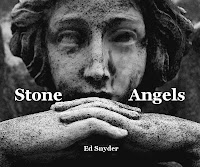Sounds redundant, doesn't it? Unfortunately, yesterday on the news (FOX 29), there was a story about a huge sink hole that appeared in Allentown Pennsylvania (about 60 miles north of Philadelphia). Sink holes, for the uninitiated, are chunks of land that collapse downward into open space, space usually created (in northeast PA anyway), by old coal mines. The effect is similar to a sunken grave, when the old wooden coffin disintegrates and collapses into itself. This creates a void in the earth that allows the ground to fall - I'm sure you've seen such depressions in the earth as you've walked through old cemeteries. (If a concrete vault is used to hold the coffin, this doesn't occur.)
I didn't take any of these photos you see here - they're all from the website LehighValleyLive.com. You can visit their site to see and read more. I have been to some of the Allentown cemeteries.
 The sink hole appears to have given way in the middle of a street, and will prompt the demolition of at least two nearby homes. You can see portions of West End Cemetery in the photos. The coroner has gotten permission to exhume and move bodies if need be.
The sink hole appears to have given way in the middle of a street, and will prompt the demolition of at least two nearby homes. You can see portions of West End Cemetery in the photos. The coroner has gotten permission to exhume and move bodies if need be.
 This is in the historic "Old Allentown" district of the city. Watch this Fox 29 news video to appreciate the magnitude the problem. (Listen to the part about the guy whose foot went through his basement floor and the hole started to fill up with water!) When a sink hole occurs, no one really knows when it will stop growing or even how deep it is! This particular one may take weeks to fill and repair. Even more frightening is the possibility of underground mine fires associated with sink holes, the most infamous ones that burned for decades turning Centralia, PA, into the ghost town it is today.
This is in the historic "Old Allentown" district of the city. Watch this Fox 29 news video to appreciate the magnitude the problem. (Listen to the part about the guy whose foot went through his basement floor and the hole started to fill up with water!) When a sink hole occurs, no one really knows when it will stop growing or even how deep it is! This particular one may take weeks to fill and repair. Even more frightening is the possibility of underground mine fires associated with sink holes, the most infamous ones that burned for decades turning Centralia, PA, into the ghost town it is today.
It appears that the Allentown sink hole caused a water main break, adding insult to injury. A dozen homes near North Tenth and West Chew streets have been evacuated.
 I used to live about fifty miles further north than Allentown, in far northeast PA, Larksville, to be exact. The mountain my parents lived on actually smoked - a light smoke would always be coming from the ground as underground mine fires slowly burned the coal buried down deep. You wonder how people live like that, but they do. Sink holes, big and small, were also a way of life - a result of a hundred years of deep vein coal mining in the region.
I used to live about fifty miles further north than Allentown, in far northeast PA, Larksville, to be exact. The mountain my parents lived on actually smoked - a light smoke would always be coming from the ground as underground mine fires slowly burned the coal buried down deep. You wonder how people live like that, but they do. Sink holes, big and small, were also a way of life - a result of a hundred years of deep vein coal mining in the region.
Back in the 1970s, my Mom worked as a part-time housekeeper for a family in an affluent section of nearby Kingston, PA. One day she heard the teenage daughter scream from the basement. She ran from the first-floor kitchen to the basement door and started to run down the steps. She looked down and saw the girl at the bottom of the stairs watching in horror as the bathroom slowly disappeared into an ever-widening hole in the floor! My Mom grabbed the girl's hand and pulled her up the stairs, and out of the house! No one was hurt - physically, anyway. Property values, as you can imagine, plummeted.
I didn't take any of these photos you see here - they're all from the website LehighValleyLive.com. You can visit their site to see and read more. I have been to some of the Allentown cemeteries.
 The sink hole appears to have given way in the middle of a street, and will prompt the demolition of at least two nearby homes. You can see portions of West End Cemetery in the photos. The coroner has gotten permission to exhume and move bodies if need be.
The sink hole appears to have given way in the middle of a street, and will prompt the demolition of at least two nearby homes. You can see portions of West End Cemetery in the photos. The coroner has gotten permission to exhume and move bodies if need be. This is in the historic "Old Allentown" district of the city. Watch this Fox 29 news video to appreciate the magnitude the problem. (Listen to the part about the guy whose foot went through his basement floor and the hole started to fill up with water!) When a sink hole occurs, no one really knows when it will stop growing or even how deep it is! This particular one may take weeks to fill and repair. Even more frightening is the possibility of underground mine fires associated with sink holes, the most infamous ones that burned for decades turning Centralia, PA, into the ghost town it is today.
This is in the historic "Old Allentown" district of the city. Watch this Fox 29 news video to appreciate the magnitude the problem. (Listen to the part about the guy whose foot went through his basement floor and the hole started to fill up with water!) When a sink hole occurs, no one really knows when it will stop growing or even how deep it is! This particular one may take weeks to fill and repair. Even more frightening is the possibility of underground mine fires associated with sink holes, the most infamous ones that burned for decades turning Centralia, PA, into the ghost town it is today. It appears that the Allentown sink hole caused a water main break, adding insult to injury. A dozen homes near North Tenth and West Chew streets have been evacuated.
 I used to live about fifty miles further north than Allentown, in far northeast PA, Larksville, to be exact. The mountain my parents lived on actually smoked - a light smoke would always be coming from the ground as underground mine fires slowly burned the coal buried down deep. You wonder how people live like that, but they do. Sink holes, big and small, were also a way of life - a result of a hundred years of deep vein coal mining in the region.
I used to live about fifty miles further north than Allentown, in far northeast PA, Larksville, to be exact. The mountain my parents lived on actually smoked - a light smoke would always be coming from the ground as underground mine fires slowly burned the coal buried down deep. You wonder how people live like that, but they do. Sink holes, big and small, were also a way of life - a result of a hundred years of deep vein coal mining in the region.Back in the 1970s, my Mom worked as a part-time housekeeper for a family in an affluent section of nearby Kingston, PA. One day she heard the teenage daughter scream from the basement. She ran from the first-floor kitchen to the basement door and started to run down the steps. She looked down and saw the girl at the bottom of the stairs watching in horror as the bathroom slowly disappeared into an ever-widening hole in the floor! My Mom grabbed the girl's hand and pulled her up the stairs, and out of the house! No one was hurt - physically, anyway. Property values, as you can imagine, plummeted.

















































